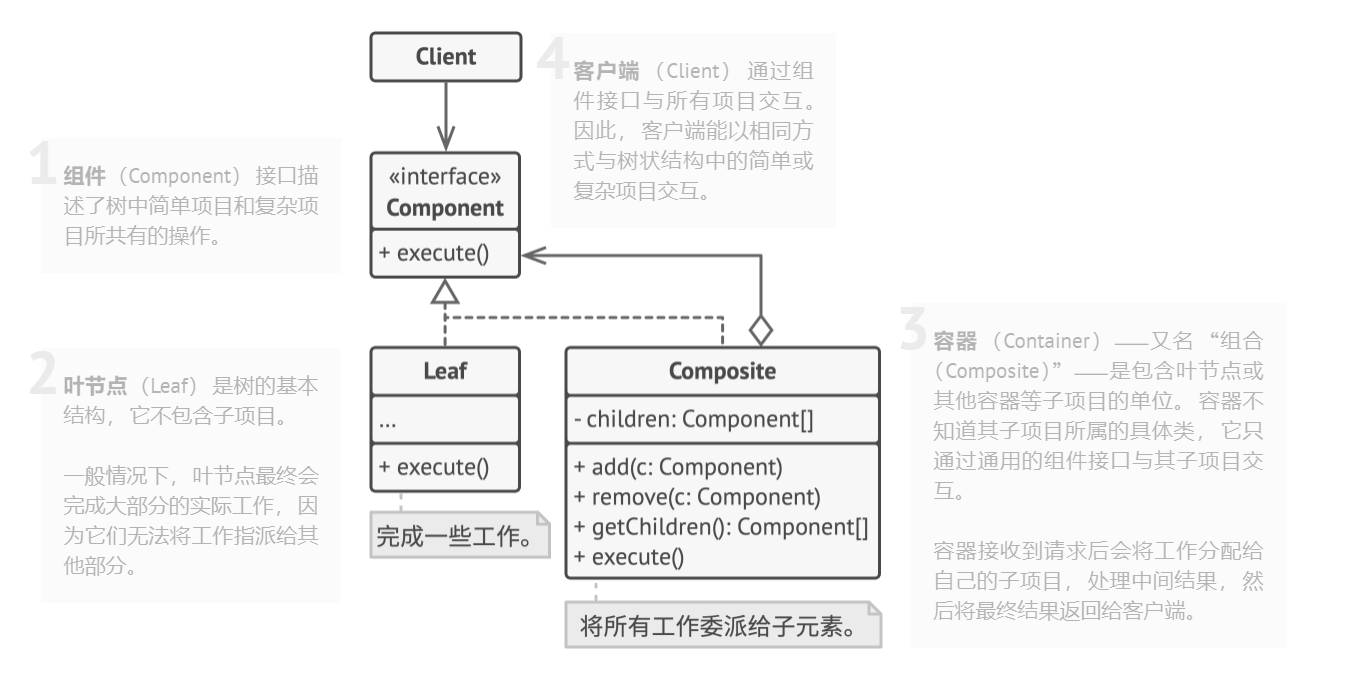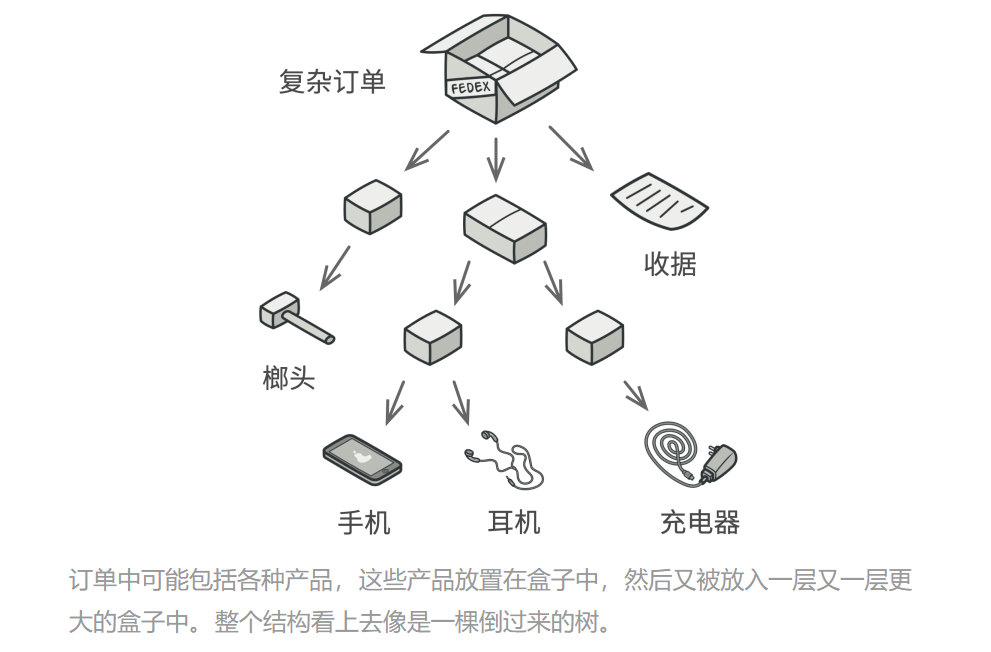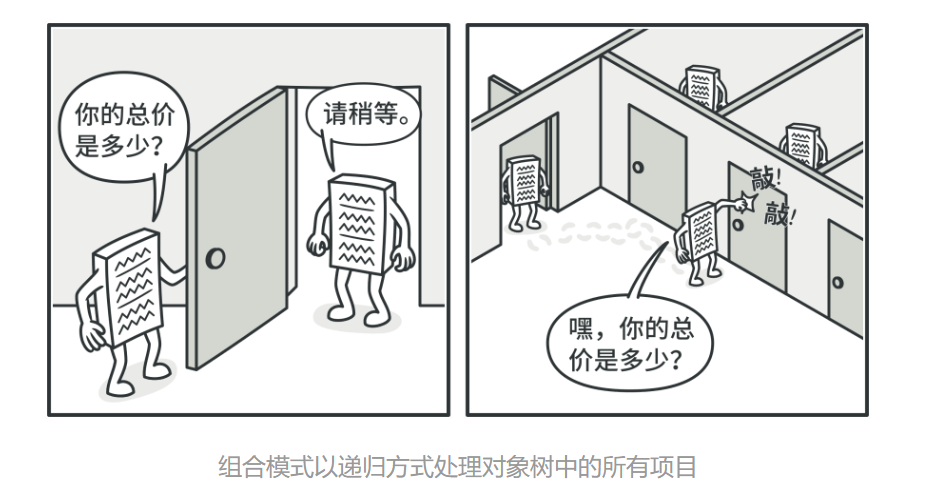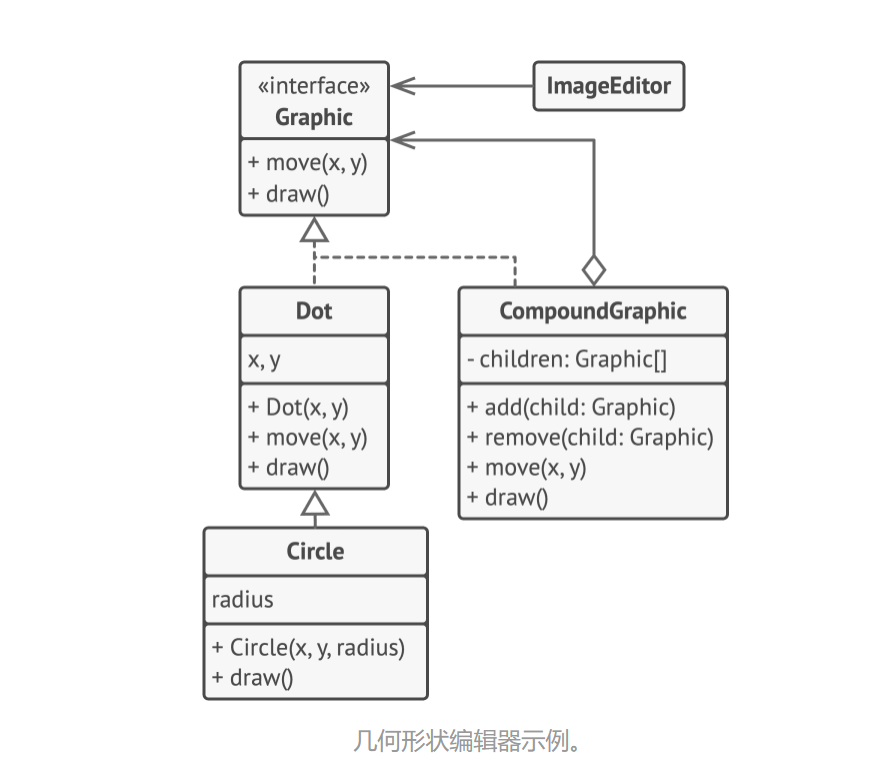一、组合模式的介绍
组合模式是一种结构型设计模式, 它将对象组合成树形结构以表示“整体-部分”的层次结构。组合模式使得用户对单个对象和组合对象的使用具有一致性。
换句话说:
- 可以把“一个对象”和“多个对象的组合”统一对待。
- 客户端代码不需要区分处理的是“叶子节点”还是“容器节点”。
二、组合模式的结构
组合模式一般包含以下角色:
- 抽象组件(Component):定义了对象的通用接口,比如 add、remove、display 等。
- 叶子节点(Leaf):表示最小的个体对象,没有子节点。
- 组合节点(Composite):作为容器,可以包含叶子节点和其他组合节点,实现了 add、remove 等方法。
- 客户端(Client):通过组件接口与对象交互,不关心是叶子还是组合。

优点:
- 统一了叶子节点和组合节点的接口,客户端使用简单。
- 可以方便地扩展树结构(新增叶子或组合类)。
- 符合“开闭原则”。
缺点:
- 设计更复杂,需要抽象类/接口。
- 在层次较深时,可能影响性能。
使用场景:
- 文件系统(文件夹和文件)。
- GUI 界面(窗口中包含按钮、文本框等)。
- 公司组织架构(部门、员工)。
- 游戏中的场景树(节点包含子节点)。
三、实例分析
问题:
如果应用的核心模型能用树状结构表示, 在应用中使用组合模式才有价值。
例如, 你有两类对象: 产品和盒子 。 一个盒子中可以包含多个 产品或者几个较小的盒子 。 这些小盒子中同样可以包含一些 产品或更小的 盒子 , 以此类推。
假设你希望在这些类的基础上开发一个定购系统。 订单中可以包含无包装的简单产品, 也可以包含装满产品的盒子…… 以及其他盒子。 此时你会如何计算每张订单的总价格呢?

你可以尝试直接计算: 打开所有盒子, 找到每件产品, 然后计算总价。 这在真实世界中或许可行, 但在程序中, 你并不能简单地使用循环语句来完成该工作。 你必须事先知道所有 产品和 盒子的类别, 所有盒子的嵌套层数以及其他繁杂的细节信息。 因此, 直接计算极不方便, 甚至完全不可行。
解决方案:
组合模式建议使用一个通用接口来与产品和盒子进行交互, 并且在该接口中声明一个计算总价的方法。
那么方法该如何设计呢? 对于一个产品, 该方法直接返回其价格; 对于一个盒子, 该方法遍历盒子中的所有项目, 询问每个项目的价格, 然后返回该盒子的总价格。 如果其中某个项目是小一号的盒子, 那么当前盒子也会遍历其中的所有项目, 以此类推, 直到计算出所有内部组成部分的价格。 你甚至可以在盒子的最终价格中增加额外费用, 作为该盒子的包装费用。

该方式的最大优点在于你无需了解构成树状结构的对象的具体类。 你也无需了解对象是简单的产品还是复杂的盒子。 你只需调用通用接口以相同的方式对其进行处理即可。 当你调用该方法后, 对象会将请求沿着树结构传递下去。
三、示例代码
假设我们要表示一个文件夹-文件系统:
#include <iostream>
#include <vector>
#include <memory>
using namespace std;
// 抽象组件
class FileSystemNode {
public:
virtual void show(int depth = 0) const = 0;
virtual ~FileSystemNode() = default;
};
// 叶子节点:文件
class File : public FileSystemNode {
string name;
public:
File(const string& n) : name(n) {}
void show(int depth = 0) const override {
cout << string(depth, '-') << "File: " << name << endl;
}
};
// 组合节点:文件夹
class Folder : public FileSystemNode {
string name;
vector<shared_ptr<FileSystemNode>> children;
public:
Folder(const string& n) : name(n) {}
void add(shared_ptr<FileSystemNode> node) {
children.push_back(node);
}
void show(int depth = 0) const override {
cout << string(depth, '-') << "Folder: " << name << endl;
for (auto& child : children) {
child->show(depth + 2);
}
}
};
// 客户端
int main() {
auto root = make_shared<Folder>("root");
auto folder1 = make_shared<Folder>("docs");
auto folder2 = make_shared<Folder>("images");
auto file1 = make_shared<File>("a.txt");
auto file2 = make_shared<File>("b.txt");
auto file3 = make_shared<File>("photo.jpg");
folder1->add(file1);
folder1->add(file2);
folder2->add(file3);
root->add(folder1);
root->add(folder2);
root->show();
return 0;
}
Qt 组合模式示例:自定义 UI 组件树:
我们要实现一个抽象组件 UIComponent,它可以是 控件(叶子节点) 或 容器(组合节点,包含子控件),最终在 Qt 界面上展示。
#include <QApplication>
#include <QWidget>
#include <QPushButton>
#include <QVBoxLayout>
#include <QString>
#include <QDebug>
// 抽象组件
class UIComponent {
public:
virtual QWidget* widget() = 0; // 返回 Qt 控件
virtual void add(UIComponent* comp) { Q_UNUSED(comp); } // 默认不实现
virtual ~UIComponent() = default;
};
// 叶子节点:具体控件(比如按钮)
class UIButton : public UIComponent {
QPushButton* m_button;
public:
UIButton(const QString& text) {
m_button = new QPushButton(text);
}
QWidget* widget() override {
return m_button;
}
};
// 组合节点:容器(比如垂直布局的 QWidget)
class UIContainer : public UIComponent {
QWidget* m_widget;
QVBoxLayout* m_layout;
public:
UIContainer(const QString& title = "") {
m_widget = new QWidget;
m_layout = new QVBoxLayout(m_widget);
if (!title.isEmpty()) {
m_widget->setWindowTitle(title);
}
}
void add(UIComponent* comp) override {
m_layout->addWidget(comp->widget());
}
QWidget* widget() override {
return m_widget;
}
};
// 客户端
int main(int argc, char *argv[]) {
QApplication app(argc, argv);
// 根容器
UIContainer root("组合模式示例");
// 子容器
UIContainer* subContainer = new UIContainer;
// 按钮(叶子节点)
UIButton* btn1 = new UIButton("按钮 A");
UIButton* btn2 = new UIButton("按钮 B");
UIButton* btn3 = new UIButton("按钮 C");
// 组合结构
root.add(btn1);
subContainer->add(btn2);
subContainer->add(btn3);
root.add(subContainer);
// 显示
root.widget()->show();
return app.exec();
}
运行效果:
- 主窗口标题为 组合模式示例。
- 窗口中有一个按钮 A,以及一个子容器(里面放了按钮 B 和 C)。
- 客户端代码完全不区分“按钮”还是“容器”,都通过 UIComponent* 统一管理。
思路说明:
- UIComponent:抽象接口,类似 Component。
- UIButton:叶子节点(单个控件)。
- UIContainer:组合节点(内部有 QVBoxLayout,可以添加子节点)。
- 客户端 main:只调用 add,不关心是按钮还是容器。
我们将借助组合模式帮助你在图形编辑器中实现一系列的几何图形:

组合图形CompoundGraphic是一个容器, 它可以由多个包括容器在内的子图形构成。 组合图形与简单图形拥有相同的方法。 但是, 组合图形自身并不完成具体工作, 而是将请求递归地传递给自己的子项目, 然后 “汇总” 结果。
通过所有图形类所共有的接口, 客户端代码可以与所有图形互动。 因此, 客户端不知道与其交互的是简单图形还是组合图形。 客户端可以与非常复杂的对象结构进行交互, 而无需与组成该结构的实体类紧密耦合。
代码实现:
#include <iostream>
#include <vector>
#include <memory>
using namespace std;
// 图形接口(Component)
class Graphic {
public:
virtual ~Graphic() = default;
virtual void move(int x, int y) = 0;
virtual void draw() const = 0;
};
// 点(Leaf)
class Dot : public Graphic {
protected:
int x, y;
public:
Dot(int x, int y) : x(x), y(y) {}
void move(int dx, int dy) override {
x += dx;
y += dy;
}
void draw() const override {
cout << "Draw a Dot at (" << x << "," << y << ")\n";
}
};
// 圆(Leaf 的扩展)
class Circle : public Dot {
int radius;
public:
Circle(int x, int y, int r) : Dot(x, y), radius(r) {}
void draw() const override {
cout << "Draw a Circle at (" << x << "," << y
<< ") with radius " << radius << "\n";
}
};
// 组合图形(Composite)
class CompoundGraphic : public Graphic {
vector<shared_ptr<Graphic>> children;
public:
void add(shared_ptr<Graphic> child) {
children.push_back(child);
}
void remove(shared_ptr<Graphic> child) {
children.erase(
remove(children.begin(), children.end(), child), children.end());
}
void move(int dx, int dy) override {
for (auto& child : children) {
child->move(dx, dy);
}
}
void draw() const override {
cout << "Draw CompoundGraphic:\n";
for (auto& child : children) {
child->draw();
}
}
};
// 客户端:图像编辑器
class ImageEditor {
shared_ptr<CompoundGraphic> all;
public:
ImageEditor() {
all = make_shared<CompoundGraphic>();
}
void load() {
shared_ptr<Dot> dot = make_shared<Dot>(1, 2);
shared_ptr<Circle> circle = make_shared<Circle>(5, 3, 10);
all->add(dot);
all->add(circle);
}
void groupSelected() {
// 简单模拟:组合所有图形
cout << "Group selected graphics:\n";
all->draw();
}
};
int main() {
ImageEditor editor;
editor.load();
editor.groupSelected();
cout << "\nMove all graphics by (2,3):\n";
// 移动所有图形
editor.groupSelected();
}





















 650
650

 被折叠的 条评论
为什么被折叠?
被折叠的 条评论
为什么被折叠?








